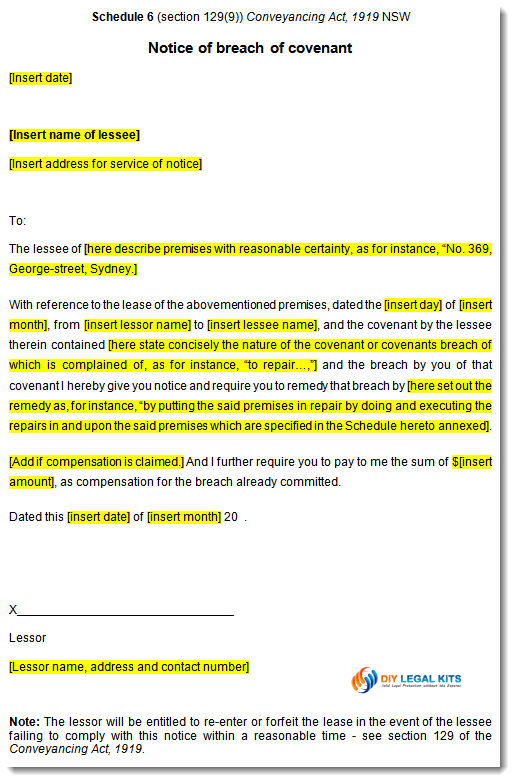It is a situation landlords hope they will never experience. Their tenant has stopped paying rent and they need to take action to mitigate the damage to their bottom line. The Landlord needs to consider whether they will terminate their commercial lease agreement.
But how does a commercial investor go about evicting a tenant who has stopped paying the rent (financial breach) or  breaches the lease in another way (non-financial breach)?
breaches the lease in another way (non-financial breach)?
Unfortunately for landlords (but fortunately for tenants!), if you have a problem with your tenants, you can’t just issue an eviction notice, minimise your losses and move on.
There are certain procedures that must be followed, or you might end up in court at the suit of the tenant, over technical or practical flaws in the way the breach was handled.
Commercial leases are covered by state specific legislation which outlines how a breach should be handled.
For example, if you are in New South Wales, your commercial lease will most likely be covered by the Conveyancing Act, the Real Property Act and, if it is also classed as a retail lease, by the Retail Leases Act. This article is written on the basis that the Conveyancing Act and Real Property Act apply (ie. to a factory, warehouse or other type or non-retail commercial property).
The terms contained in the lease agreement itself will also come into play when dealing with a breach of lease.
Explanation of terminology
![]() Re-entry – Leases also frequently include a right of re-entry allowing the lessor to reclaim the property if the lessee fails to abide by the terms of the lease. When the lessor exercises the right of re-entry and reclaims the property, the lessee has no further right to the premises. However, the lessor may have to take reasonable care to prevent damage to any Personal Property left on the premises by the lessee.
Re-entry – Leases also frequently include a right of re-entry allowing the lessor to reclaim the property if the lessee fails to abide by the terms of the lease. When the lessor exercises the right of re-entry and reclaims the property, the lessee has no further right to the premises. However, the lessor may have to take reasonable care to prevent damage to any Personal Property left on the premises by the lessee.
![]() Forfeiture – If the Tenant hasn’t paid the rent, the landlord can declare the tenant’s rights, and the lease, forfeited by the tenant’s breach. The tenant will be liable for landlord’s damages, including unpaid rent not paid by a another tenant, forfeiture costs, damages to the premises, advertising costs, etc
Forfeiture – If the Tenant hasn’t paid the rent, the landlord can declare the tenant’s rights, and the lease, forfeited by the tenant’s breach. The tenant will be liable for landlord’s damages, including unpaid rent not paid by a another tenant, forfeiture costs, damages to the premises, advertising costs, etc
If a tenant has breached the lease, either by failing to pay rent, or in some other way, the landlord must follow a certain procedure before the tenant can be evicted.
This is a general guide only and will vary slightly from state to state, depending on the state specific legislation that applies and the particular terms of your lease. For example, in New South Wales, section 129 of the Conveyancing Act, 1919 states that before a right of re-entry or forfeiture under any provision of a lease (for breach of the lease) is enforceable, the lessor must first serve on the lessee a notice that:
- specifies the particular breach;
- if the breach is capable of remedy, requiring the lessee to remedy the breach; and
- in the event the lessor is claiming compensation, requiring the lessee to pay the compensation.
This requirement does not apply to re-entry or forfeiture in the event of non-payment of rent (sub-section (8) of s 129 Conveyancing Act). However, most leases will still require the landlord to give a notice to remedy a breach of non-payment of rent, so make sure you look to the terms of your lease in this regard.
The Conveyancing Act requires the notice to remedy the breach to be in the form prescribed by the Act (contained at schedule 6 of the Act), or in a similar form. A copy of the prescribed form appears below.
If the lessor has not given the tenant the necessary notice before enforcing a right of re-entry or forfeiture under a commercial lease, the tenant may personally bring a suit against the lessor and apply to the court for relief.
The right steps to take
If you find yourself in a situation where you need to take steps to exercise your right of forfeiture or re-entry, the general procedure (depending on the state based legislation that will apply to you and the specific terms and conditions of you lease), is as follows:-
- Identify the breach. In what way has the tenant breached the lease or legislation? This might be a financial breach (for example, the non-payment of rent) or a non-financial breach (failing to keep premises in a certain state of repair);
- Give the tenant written notice to remedy the breach. In your notice, specify the particulars of the breach and request the tenant remedy the breach (if the breach is capable of remedy and most are) within a stated reasonable timeframe. You should also state the steps that may be taken to remedy the breach. If compensation is payable, stipulate any compensation that you may require the tenant to pay. To summarise, the notice must:
- be dated;
- identify the lessee and be correctly addressed to the lessee;
- identify the lease;
- identify the provision of the lease that has been breached;
- set out the rectification required;
- stipulate the reasonable timeframe by which the remedy must be completed;
- stipulate any compensation that is required to be paid (if any);
- contain any other mandatory information set out in the state legislation, such as this warning to the tenant contained in the prescribed form notice to remedy of the Conveyancing Act, NSW:
“Note: the lessor will be entitled re-enter or forfeit the lease in the event of the lessee failing to comply with the notice within a reasonable time. See Section 129 of the Conveyancing Act 1919.”
- If the tenant does not remedy the breach in the allotted time, the landlord can terminate the lease, for example, by re-entry, notice or initiating court proceedings.
Goods at premises
What is to be done with the personal effects of the tenant at the premises after an eviction? At common law, the tenant has a right to enter the land for the limited purpose of retaking possession of their goods. As such, the landlord should allow the tenant to come onto the property to collect their goods.
If the tenant does not collect their goods, then the goods can ultimately be stored and eventually sold by the landlord pursuant to Part IVA of the Landlord and Tenant Act 1958 (Vic).110
A common cause of court battles
Litigation battles over the validity of notices to remedy or whether a lease has been validly terminated are rampant in the court system. As such, it is imperative that landlords ensure the validity of the notice.
It is vital that the notice is correct both factually (that is, the details of the breach are accurate and correct) and in form and content (that is, the notice is in the correct prescribed form or similar, contains all of the required information, and otherwise technically complies with the requirements of a valid notice to remedy).
If the notice is found to be invalid, (for example, the form contains technical errors or the circumstances of the breach are not accurate), then the lessor may have to re-issue fresh notices and start proceedings anew.
Extract from Conveyancing Act, 1919

![]() Download Word Doc of Notice of Breach.
Download Word Doc of Notice of Breach.
Text Version
“Schedule 6 (section 129(9))
Notice of breach of covenant
To
The lessee of [here describe premises with reasonable certainty, as for instance, “No. 369, George-street, Sydney.]
With reference to the lease of the abovementioned premises, dated the day of1, from A.B. to C.D., and the covenant by the lessee therein contained [here state concisely the nature of the covenant or covenants breach of which is complained of, as for instance, “to repair,”] and the breach by you of that covenant I hereby give you notice and require you to remedy that breach by [here set out the remedy as, for instance, “by putting the said premises in repair by doing and executing the repairs in and upon the said premises which are specified in the Schedule hereto annexed.” Add if compensation is claimed.] And I further require you to pay to me the sum of, as compensation for the breach already committed.
Dated this day of 20 .
Lessor.
Note : The lessor will be entitled to re-enter or forfeit the lease in the event of the lessee failing to comply with this notice within a reasonable time-see section 129 of the Conveyancing Act 1919.”
More information
Commercial Lease Agreement Template Kits for Each Australian State
 This easy-to-use template kit contains everything you need to successfully lease your commercial premises. It contains the Lease Agreement Template, Easy-to-follow Users Guide and Agreement to Lease
This easy-to-use template kit contains everything you need to successfully lease your commercial premises. It contains the Lease Agreement Template, Easy-to-follow Users Guide and Agreement to Lease
When can you break a Commercial Lease Agreement?
 In this economic climate, it is not a far stretch to imagine commercial businesses in the unfortunate position of having to end a lease early. In this article, we consider the ways a tenant may be able to exit a Lease in a commercial setting.
In this economic climate, it is not a far stretch to imagine commercial businesses in the unfortunate position of having to end a lease early. In this article, we consider the ways a tenant may be able to exit a Lease in a commercial setting.
Terminating Commercial Leases for Non-payment of Rent – Validity of Law Society Lease Questioned
 A recent decision of the New South Wales Civil and Administrative Tribunal (Charlie Bridge Street Pty Limited v Petrazzuolo: Petrazzuolo v Charlie Bridge Street Pty Limited [2019] NSW CATCD1) has raised some interesting issues about the right of a landlord to terminate a lease for non-payment of rent without giving notice to the tenant. The decision also found that a provision of the printed Law Society of NSW lease does not comply with section 129 of the Conveyancing Act and is therefore inoperable.
A recent decision of the New South Wales Civil and Administrative Tribunal (Charlie Bridge Street Pty Limited v Petrazzuolo: Petrazzuolo v Charlie Bridge Street Pty Limited [2019] NSW CATCD1) has raised some interesting issues about the right of a landlord to terminate a lease for non-payment of rent without giving notice to the tenant. The decision also found that a provision of the printed Law Society of NSW lease does not comply with section 129 of the Conveyancing Act and is therefore inoperable.

